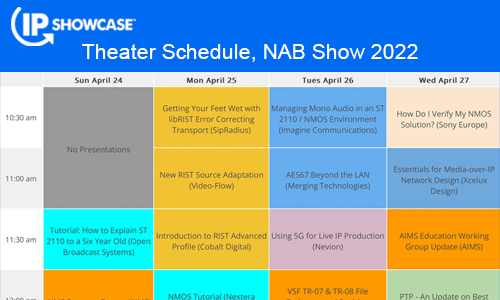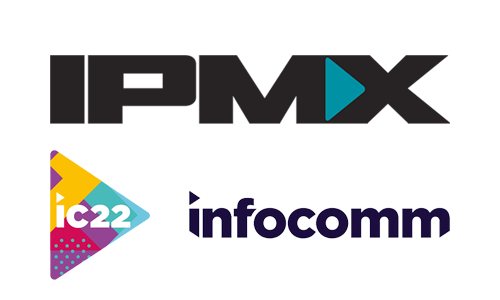Barco, global leader in visualization and image processing technologies, is a new member of the Alliance for IP Media Solutions (AIMS). With AIMS’ new Internet Protocol Media Experience (IPMX) set of open standards and specifications gaining traction in the Pro AV industry, the Barco membership ties in with the company’s perspective and roadmap in terms of AV-over-IP solutions.
The Alliance for IP Media Solutions (AIMS) will host its first live interoperability demonstration of Internet Protocol Media Experience (IPMX) — a set of standards-based protocols designed to ensure interoperability for AV over IP — at InfoComm 2022, June 8-10 at the Las Vegas Convention Center.
John Mailhot, CTO of infrastructure and networking at Imagine Communications, looks at standards for television signals over packet-based (ethernet/IP) networks
In Las Vegas, AVNation’s Bradford Benn is back in the InfoComm 2022 studio with Andre Testa, the Senior Director of FPG and Hardware Engineering at Matrox. Matrox is part of AIMS, a networking topology organization that’s promoting IPMX as an industry open standard.
As part of our ongoing AVT Thought Leaders Series, we asked Sam Recine, Chair, Pro AV Working Group, AIMS to provide a rare insider’s perspective into the company’s philosophy and product roadmap heading into InfoComm 2022.
Recordings of the IP Showcase Theater presentations from NAB 2022 are now available for viewing on the IP Showcase site here.
The Alliance for IP Media Solutions (AIMS) will host its first live interoperability demonstration of Internet Protocol Media Experience (IPMX) — a set of standards-based protocols designed to ensure interoperability for AV over IP — at InfoComm 2022, June 8-10 at the Las Vegas Convention Center. The first-of-a-kind demo will take place at AIMS Booth W1067 and will feature networking equipment and hardware and software nodes running both IPMX and SMPTE ST 2110, the standards suite on which IPMX is based. The demo will also highlight gateways between IPMX and other protocols, developer kits, and elements of IPMX-enabled AV-over-IP workflows.
“With this noteworthy IPMX interoperability demo at InfoComm 2022, we’re passing a critical milestone on the AIMS roadmap for open-standards-based media over IP,” said Sam Recine, chair of the Pro AV Working Group at AIMS. “We’re demonstrating the technical viability of IPMX in terms of multivendor interoperability, and that alone is exciting! But what’s also significant about this demo is the high level of industry support it signals, with leading manufacturers building IPMX support into their products — and more companies continually joining those ranks — as we move toward a more flexible, dynamic IP-based future for Pro AV.”
IPMX implements a standards-based approach based on SMPTE ST 2110, with features and capabilities that target the specific needs of the Pro AV industry. In addition to simplifying implementation of SMPTE ST 2110 and ensuring interoperability for AV-over-IP systems, IPMX incorporates other features tailored to Pro AV installations. These features include AMWA NMOS IS-04 and IS-05 for discovery, registration, and connection management, as well as specifications for copy protection and security.
Demo partners include Arista Networks, Cisco Systems, intoPix SA, Macnica, Matrox, Ross Video Limited, Stagetec and many others.
The Audio Engineering Society (AES), Alliance for IP Media Solutions (AIMS), Advanced Media Workflow Association (AMWA), European Broadcasting Union (EBU), SMPTE®, and the Video Services Forum (VSF) today revealed the IP Showcase presentation schedule for the 2022 NAB Show, April 23-27, in Las Vegas. The daily series of sequential, live 30-minute presentations in the IP Showcase booth (W5222) will start at 10:30 a.m. each morning and extend into the afternoon.
“Over the course of the 2022 NAB Show, more than 30 live presentations on the AIMS booth will delve into the latest technical achievements in media over IP, implementation of standards-based IP infrastructures for real-time professional media applications, market deployments from facilities around the world, and technical advances on the horizon,” said IP Showcase Chairperson Andrew Starks. “Attendees can participate in a truly impressive array of presentations showcasing top experts, cutting-edge facilities, and the topics of most interest to broadcast and Pro AV engineers guiding their organizations toward IP-based operations.”
The IP Showcase is committed to educating attendees at major industry events on the business and creative potential of IP media solutions. Presentations at the 2022 NAB Show will explore SMPTE ST 2110 from a variety of perspectives — training and education, architecture, audio management, connectivity, and more. Experts will speak on NMOS, offering a broad tutorial and getting into specifics with more focused presentations. Numerous sessions will provide practical guidance, both through case studies profiling real-world implementations and through reviews of best practices related to IP production, QC, monitoring, timing, and more.
The current IP Showcase presentation schedule for the 2022 NAB Show is online at www.ipshowcase.org. Further information about IP Showcase is available at www.ipshowcase.org.
More information about the sponsoring organizations is available at:
Audio Engineering Society (AES): www.aes.org
Alliance for IP Media Solutions (AIMS): www.aimsalliance.org
Advanced Media Workflow Association (AMWA): www.amwa.tv
European Broadcasting Union (EBU): tech.ebu.ch
SMPTE®: www.smpte.org
Video Services Forum (VSF): www.vsf.tv
More information about standards and open specifications is available at:
AIMS: aimsalliance.org/educational-library/
IPMX: ipmx.io
AES: www.aes.org/standards/blog/
AMWA: github.com/AMWA-TV/nmos
EBU: tech.ebu.ch
SMPTE ST 2110: SMPTE- www.smpte.org/smpte-st-2110-faq
VSF Technical Recommendations: videoservicesforum.org/technical_recommendations.shtml
The Alliance for IP Media Solutions (AIMS) has announced its support for the industry’s shift to more inclusive language in standards and engineering documents.
When it comes to cables in consumer electronics, there is a high premium placed on making sure technology “just works.” We’re familiar with this concept from USB but consider your lowly power cable.








